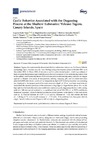Please use this identifier to cite or link to this item:
https://accedacris.ulpgc.es/jspui/handle/10553/55006
| DC Field | Value | Language |
|---|---|---|
| dc.contributor.author | Fraile Nuez,Eugenio | en_US |
| dc.contributor.author | Santana-Casiano, J. Magdalena | en_US |
| dc.contributor.author | González-Dávila, Melchor | en_US |
| dc.contributor.author | Vázquez, Juan T. | en_US |
| dc.contributor.author | Fernández-Salas, Luis Miguel | en_US |
| dc.contributor.author | Sánchez-Guillamón, Olga | en_US |
| dc.contributor.author | Palomino, Desirée | en_US |
| dc.contributor.author | Presas-Navarro, Carmen | en_US |
| dc.date.accessioned | 2019-02-18T16:06:35Z | - |
| dc.date.available | 2019-02-18T16:06:35Z | - |
| dc.date.issued | 2018 | en_US |
| dc.identifier.issn | 2076-3263 | en_US |
| dc.identifier.other | WoS | - |
| dc.identifier.uri | https://accedacris.ulpgc.es/handle/10553/55006 | - |
| dc.description.abstract | Tagoro, the most recently discovered shallow submarine volcano on the Canary Islands archipelago, Spain, has been studied from the beginning of its eruptive phase in October 2011 until November 2018. In March 2012, it became an active hydrothermal system involving a release of heat and gases that produce significant physical–chemical anomalies in the surrounding waters close to the seabed. Fast Fourier transform (FFT) and wavelet time-domain-frequency analysis techniques applied to filtered time series of temperature, salinity, pressure, pH, and oxidation-reduction potential (ORP) data from a conductivity-temperature-depth (CTD) device mounted on a mooring and deployed at the deepest part of the main crater at a depth of 127 m, have been used to better understand the dynamic processes of the emissions during Tagoro’s degasification phase. Our results highlight that the hydrothermal system exhibited a stationary cyclic degassing behavior with a strong peak of a 140-min period centered on a significant interval of 130–170 min at 99.9% confidence. Moreover, important physical–chemical anomalies are still present in the interior of the main crater, such as: (i) thermal increase of +2.55 °C, (ii) salinity decrease of −1.02, (iii) density decrease of −1.43 (kg∙m−3), and (iv) pH decrease of −1.25 units. This confirms that, five years after its origin, the submarine volcano Tagoro is still actively in a degassing phase | en_US |
| dc.language | eng | en_US |
| dc.relation.ispartof | Geosciences (Switzerland) | en_US |
| dc.source | Geosciences [ISSN 2076-3263], v. 8 (12), (Diciembre 2018) | en_US |
| dc.subject | 251002 Oceanografía química | en_US |
| dc.subject.other | Hydrothermal vents | - |
| dc.subject.other | Cyclic behavior | - |
| dc.subject.other | Submarine volcano | - |
| dc.subject.other | Tagoro | - |
| dc.subject.other | El Hierro (Canary Islands) | - |
| dc.subject.other | Baja-California-Sur | - |
| dc.subject.other | Wavelet Transform | - |
| dc.subject.other | Submarine Volcano | - |
| dc.title | Cyclic behavior associated with the degassing process at the shallow submarine Volcano Tagoro, Canary Islands, Spain | en_US |
| dc.type | info:eu-repo/semantics/article | en_US |
| dc.type | Article | en_US |
| dc.identifier.doi | 10.3390/geosciences8120457 | en_US |
| dc.identifier.scopus | 85058483594 | - |
| dc.identifier.isi | 000455388200030 | - |
| dc.contributor.authorscopusid | 12139561900 | - |
| dc.contributor.authorscopusid | 6701344294 | - |
| dc.contributor.authorscopusid | 6603931257 | - |
| dc.contributor.authorscopusid | 7401760866 | - |
| dc.contributor.authorscopusid | 6507283464 | - |
| dc.contributor.authorscopusid | 56719868700 | - |
| dc.contributor.authorscopusid | 35093114700 | - |
| dc.contributor.authorscopusid | 57197858857 | - |
| dc.identifier.issue | 457 | - |
| dc.relation.volume | 8 | en_US |
| dc.investigacion | Ciencias | - |
| dc.type2 | Artículo | en_US |
| dc.contributor.daisngid | 1139939 | - |
| dc.contributor.daisngid | 579253 | - |
| dc.contributor.daisngid | 30362855 | - |
| dc.contributor.daisngid | 881856 | - |
| dc.contributor.daisngid | 1198600 | - |
| dc.contributor.daisngid | 7732662 | - |
| dc.contributor.daisngid | 3559425 | - |
| dc.contributor.daisngid | 29492103 | - |
| dc.description.numberofpages | 15 | en_US |
| dc.utils.revision | Sí | - |
| dc.contributor.wosstandard | WOS:Fraile-Nuez, E | - |
| dc.contributor.wosstandard | WOS:Santana-Casiano, JM | - |
| dc.contributor.wosstandard | WOS:Gonzalez-Davila, M | - |
| dc.contributor.wosstandard | WOS:Vazquez, JT | - |
| dc.contributor.wosstandard | WOS:Fernandez-Salas, LM | - |
| dc.contributor.wosstandard | WOS:Sanchez-Guillamon, O | - |
| dc.contributor.wosstandard | WOS:Palomino, D | - |
| dc.contributor.wosstandard | WOS:Presas-Navarro, C | - |
| dc.date.coverdate | Diciembre 2018 | en_US |
| dc.identifier.ulpgc | Sí | es |
| dc.description.sjr | 0,392 | |
| dc.description.jcr | 0,57 | |
| dc.description.sjrq | Q2 | |
| dc.description.jcrq | Q3 | |
| dc.description.esci | ESCI | |
| item.fulltext | Con texto completo | - |
| item.grantfulltext | open | - |
| crisitem.author.dept | GIR IOCAG: Química Marina | - |
| crisitem.author.dept | IU de Oceanografía y Cambio Global | - |
| crisitem.author.dept | Departamento de Química | - |
| crisitem.author.dept | GIR IOCAG: Química Marina | - |
| crisitem.author.dept | IU de Oceanografía y Cambio Global | - |
| crisitem.author.dept | Departamento de Química | - |
| crisitem.author.orcid | 0000-0002-7930-7683 | - |
| crisitem.author.orcid | 0000-0003-3230-8985 | - |
| crisitem.author.parentorg | IU de Oceanografía y Cambio Global | - |
| crisitem.author.parentorg | IU de Oceanografía y Cambio Global | - |
| crisitem.author.fullName | Fraile Nuez,Eugenio | - |
| crisitem.author.fullName | Santana Casiano, Juana Magdalena | - |
| crisitem.author.fullName | González Dávila, Melchor | - |
| Appears in Collections: | Artículos | |
SCOPUSTM
Citations
15
checked on Jun 8, 2025
WEB OF SCIENCETM
Citations
11
checked on Jan 12, 2026
Page view(s)
55
checked on Jan 11, 2026
Download(s)
91
checked on Jan 11, 2026
Google ScholarTM
Check
Altmetric
Share
Export metadata
Items in accedaCRIS are protected by copyright, with all rights reserved, unless otherwise indicated.
